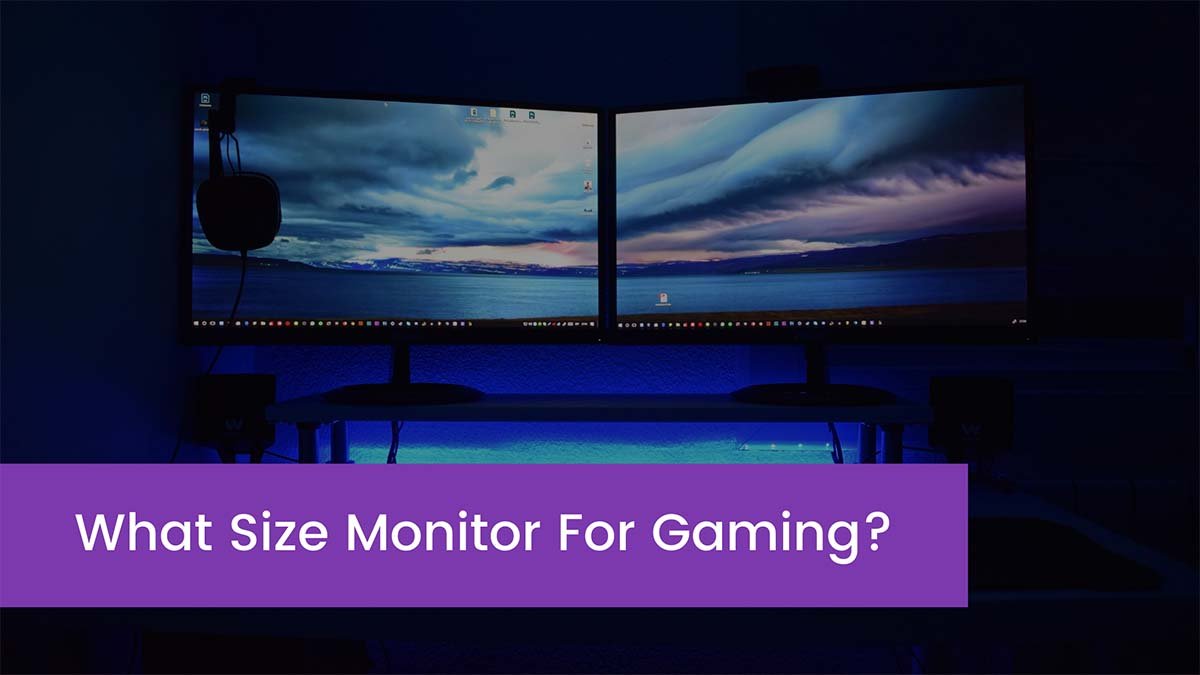What size monitor for gaming? What if you wanted to use your monitor for more than just gaming? Don’t worry if this all sounds a little overwhelming; WPC is here to assist you. We’ll help you choose the right monitor size for your gaming demands and setup now.
So, you’ve just invested in a new gaming PC and are now looking for a new gaming display to go with it. Do you dig out that dusty 60Hz monitor from the garage (which has nothing wrong with it), or do you go out and get a new one? When purchasing a gaming monitor, there are many factors to consider, and the most significant is the suitable size.
What Is the Process of Measuring Monitor Size?
Before we go into the weeds, keep in mind that monitors, like TVs, are measured diagonally. As a result, a 22-inch display will be roughly 18 inches broad and 10 inches in height. A 24-inch display, on the other hand, will be around 20 inches broad and 12 inches tall. This may not seem like much, but every few diagonal inches adds up to a big increase in screen space.
Simply locating the region will reveal the answer. One hundred eighty square inches is the result of multiplying 18 by ten. Two hundred forty square inches is the result of multiplying 20 by 12. You get 60 square inches with just two diagonal inches.
We’ll go over the standard monitor sizes and resolutions that go with them in the sections below.
What Are the Common size Monitor for gaming?
22-inch Monitor
There are many different gaming monitors available, with manufacturers catering to every budget and setting. A good place to start is around 22 inches, although gaming monitors may reach up to 49 inches ultrawide, and that’s before we talk about gaming TVs!
22-inch monitors feature resolutions ranging from 1366×768 to 1920×1080 (Full HD/1080p) and are currently considered on the smaller side. Although the advent of 24-inch monitors has largely eliminated these, you’ll still find a handful of them as good budget solutions.
24-inch Monitor
A 24-inch monitor with a 1080p resolution is the standard, which is the most common. Some 1440p and even 4K 24-inch monitors are also available, but these aren’t usually appropriate for this resolution.
27-inch Monitor
Nowadays, 1440p resolutions are common on 27-inch displays; however, 1080p and 4K resolutions are still common. These days, 27-inch monitors are the norm, with even a few esports fans opting for this over the more practical 24-inch.
32-inch Monitor
While 32-inch monitors are on the larger side, they nevertheless have a following among gamers since they provide a superior viewing experience and come in resolutions ranging from 1080p to 4K.
Bigger, Smaller, And Everything In-Between
Smaller, larger, and in-between displays are available. The sizes in between aren’t magically different; they’re unusual. However, I strongly recommend that you stick to the 24-to-27-inch size range. You will lose too much if you are too small. The idea of using a desktop computer becomes less tempting as the screen becomes bigger.
What Are Ultrawide Displays?
The aspect ratio of most current monitors is 16:9. Although 16:10 is uncommon, for this essay, we’ll assume the monitors are 16:9. However, a recent flood of 21:9 monitors, sometimes known as “Ultrawides,” is on the market.
Make no mistake: ultrawide monitors can be a fantastic option depending on the game you prefer. Racing games, in particular, benefit greatly from ultrawide displays; thus, investing in a high-resolution monitor may be worthwhile.
Many recent FPS games, for example, will not allow for a horizontal FOV greater than 90 degrees. On a 16:9 panel, this is OK, but on an ultrawide monitor, it can cause a stretched or distorted image. If you’re playing competitively or predominantly in first-person shooter games, you shouldn’t use an ultrawide display unless you know it’ll work with your games.
Furthermore, due to a large amount of screen real estate, you may find yourself taking an extra second to check the mini-map, putting you at a disadvantage to gamers with smaller aspect ratios.
When it comes to game support, ultrawide monitors are more precarious because a full implementation of ultrawide in a multiplayer game can be deemed a competitive advantage.
In the case of an ultrawide display, a wider display equals a substantially wider field of view. As a result, many multiplayer games, particularly those in the FPS genre, opt not to support ultrawide displays, at least not to the point of offering them a wider field of view. Overwatch, for example, had proper ultrawide support in beta, but Blizzard chose to reduce the FOV in the full release.
Which Monitor Size Is Most Appropriate For Me?
A 24-inch monitor is usually the greatest choice for choosing the best size display for gaming. While any size monitor can theoretically be used, a 1080p 24-inch monitor is the best option.
It’s big enough that you can see what you’re doing without turning your head, and the resolution is excellent. A 24-inch monitor is great for gaming, but you can choose a smaller or larger display depending on your preferences.
With a larger monitor, though, you may need to lift your head to see the entire screen, which isn’t necessarily ideal for many games. With a smaller monitor, this may be too small, causing you to lose out on minor game elements.
Conclusion
Different monitor sizes are best for different gaming settings, but we recommend either a 1080p 24-inch monitor or a 1440p 27-inch monitor assuming typical viewing distance and a 16:9 display. A 1440p 27-inch monitor may be too huge for some esports players, but if you can get used to it, it’s the best option overall.
Aside from monitor size, factors such as panel type and refresh rate should also be considered. Modern displays and GPUs will all support HDMI and DisplayPort, but if you’re still using VGA or DVI, double-check which ports your monitor supports and consider purchasing an adaptor if necessary.
All of this is to say that you shouldn’t buy large monitors with high resolutions unless you have the hardware to support them. Before you go out and buy a higher-resolution monitor, make sure you have a system that can handle games at your preferred resolutions.


![Read more about the article [ Best Guide ] How To Make Paper In Minecraft?](https://wuschools.com/wp-content/uploads/2022/05/how-to-Make-Paper-In-Minecraft-300x169.jpg)

![Read more about the article [ 2023 ] How To Make A Glass In Minecraft?](https://wuschools.com/wp-content/uploads/2022/05/how-to-Make-a-Glass-in-Minecraft-300x169.jpg)